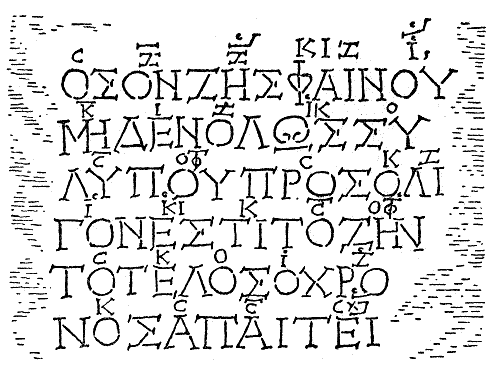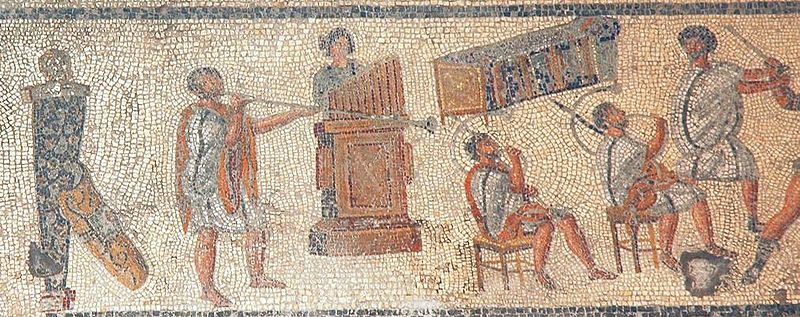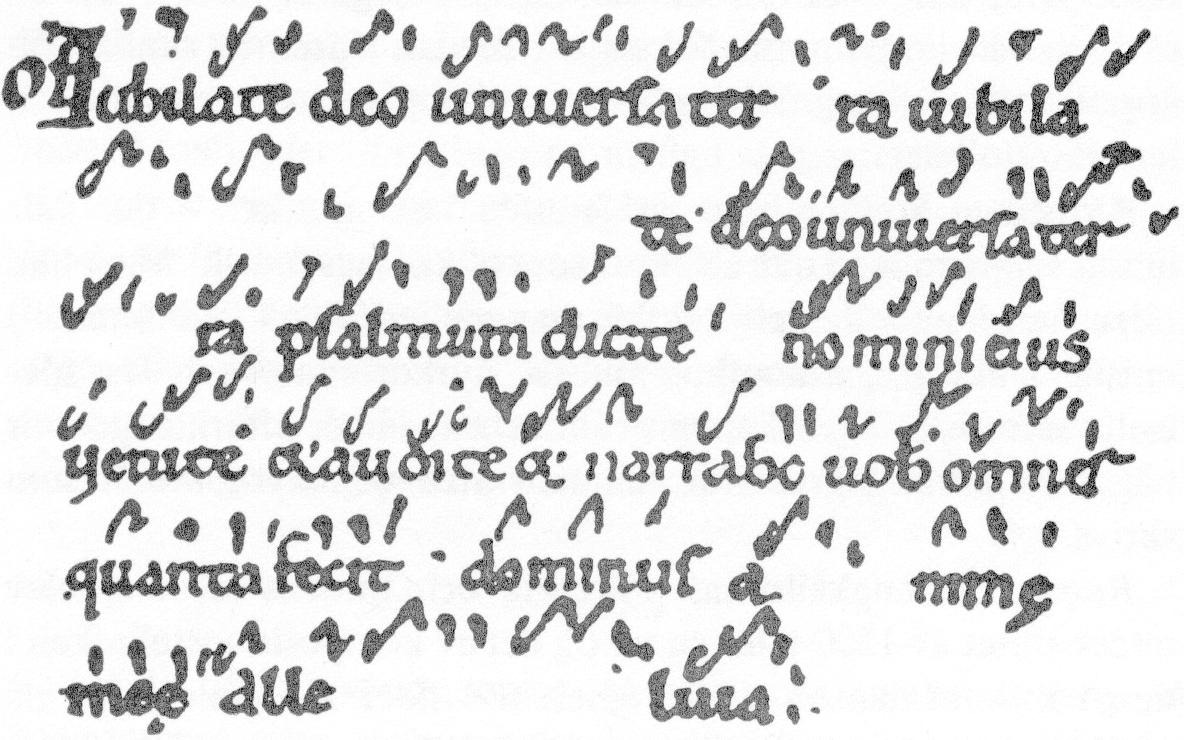
The man on the right plays a type of tambourine.

An example of Greek musical notation on a hymn to Apollo. The small marks over the letters indicate the melody. This was known as ekphonetic notation. This could only have allowed a loose interpretation of the melody and so probably no two people sang it exactly alike.

The music of Greece made its way to Rome and the instruments came with the music. Here the double-pipes and the tambourine find favor among the Romans.

A long horn is featured here and well as a small water organ called a hydraulis which the Romans inherited from the Greeks.
A clip of the music of Ancient Rome:
Ancient Roman Music - Synaulia I - YouTube
After the collapse of the Western Empire in the fifth century, Europe entered a period called the Dark Ages, so named because the infrastructure of the Empire had completely collapsed. Governance was put under the auspices of the Church and education was promptly supplanted by superstition and there was a corresponding dearth of cultural output. Europe was so in the throes of this darkness that when a nova appeared in the skies in 1054, Europe appears to be the only place on earth that did not write about nor depict it. There is an account that Charlemagne, the Frankish king of the 7th century, compiled a library of contemporary music. He would hold what amounted to open mic nights at his palace and anyone with a song could come in to perform it. If Charlemagne liked it, he would have a monk or other person skilled in writing music take it down on manuscript paper (which was made from animal skin at that time). Reportedly, he had collected thousands of songs from all corners of Frankish Empire. Many of the songs were said to be quite ribald and few, if any, were of a religious nature. As a result, upon his death, Charlemagne’s son, Louis the Pious, had the library burned. Needless to say, this is a tremendous loss to us today for this library, if it existed, would have provided us the only substantial window into what music of the Dark Ages sounded like, particularly the folksongs and secular songs.
Consequently, the earliest examples we have today of music from Central and Western Europe are religious hymns. These were done predominantly in plainchant—a monophonic style that could be sung by one voice or many in unison sans harmony. Gregorian chant is an example of plainchant. Monks in the choirs had to commit hundreds of chants to memory. Secular music, also monophonic, was performed and sung during this period but not written down until the 12th century.
Originally, these chants were passed down orally as Europe had no system of musical notation during the Dark Ages. By the 9th century, with the Dark Ages finally fading, the chants began being notated in neume notation. “Neume” is a corruption of the Greek word “pneuma” or breath/wind. Each syllable in a chant is sung in one breath and is called a neume. A nueme can consist of more than one note and usually consists of several. However, there are chants with only one note neume per syllable called syllabic while a multi-note neume syllable is called neumatic. There is another type of chant consisting of several neumes per syllable called melismatic.

Neume notation. No staff lines were used (cheironomic). The dots (which may have symbolized rising and falling hand gestures) were aids to help construct the melody but, like ekphonic notation, no two people would sing this piece the same way unless trained by the same teacher.
Neume notation probably started in the Eastern Empire as there are a great many examples of it still in existence from Turkey, Syria, Israel and Lebanon, most of it in Aramaic (the Roman Empire had fragmented into two halves in the 4th century with Rome remaining the capital of the Western Empire and Constantinople becoming the capital of the Eastern Empire which became the Byzantine Empire). It was brought to the Frankish Empire of Charlemagne who wanted the hymns sung in the tradition of the Romans. The pieces still had to be learned by ear and the notation would then function as a mnemonic device to aid the singers in forming the melody.
In the 11th century, Guido (known as Guido Monaco or Guido of Arezzo), an Italian Benedictine monk at the monastery of Pomposa, noted how the singers often had trouble remembering the chants. He decided a more precise method of preserving the chants was called for. He came up with a system that was met with praise but some monks thought he was destroying tradition and criticized him. To escape their harassment, Guido fled to the city of Arezzo where Bishop Tedald put him in charge of training the cathedral singers. Among the techniques that Guido invented were the use of staff lines and solmization.
Staff lines not only told a singer whether to sing higher or lower but also exactly which note to sing. Because the plainchants used no instruments besides voice, the staff lines didn’t solve the problem how to know one was in key nor how to sing a certain unfamiliar interval. So Guido implemented solmization where each note was represented by a syllable. The scheme ran ut-re-mi-fa-sol-la. We call this the solfeggio—do-re-mi-fa-sol-ia-si (ti)-do. Guido took his syllables from the first stanza of the 8th century “Hymn of St. John” by Paulus Diaconus:
Ut queant laxis
resonāre fibris
Mira gestorum
famuli tuorum,
Solve polluti
labii reatum,
Sancte Iohannes.
(So that these your servants can, with all their voice, sing the wonders of your deeds, clean the guilt from our stained lips, O Saint John!)
Later, “si” was added to complete the diatonic scale and was derived from “Sancte Iohannes.” By assigning a syllable to each note, the singer can internally hear the notes written on the page and then sing them.
Other sources say that Guido actually borrowed the Arabic solmization scheme of
Durar Mufassalat or “separated pearls,” which runs: Dal, ra, mim, fa, sad, lam, ta. Since Arabic and Turkish music was becoming very popular in Europe at that time, this is a distinct possibility.
With Guido’s system, the chants could be faithfully reproduced even by those who had not heard them before.

Square notation using Guido’s staff lines. The staves allowed the melody to be sung the same way by everybody.
Kyrie, Gregorian Plainchant - YouTube
Gregorian chant was an early Western form of organized music. Originally, it was monophonic as the Kyrie chant above but by the Middle Ages became almost polyphonic—a forerunner called heterophonic. This style of chant was known as organum and had a far more haunting quality:
Lullay, lullay: Als I lay on Yoolis night - YouTube
Anonymous 4 “Lullay, Lullay: Als I lay on Yoolis Night”
Chant of the Templars - Da Pacem Domine - YouTube
Chant of the Templars “Da Pacem Domine”